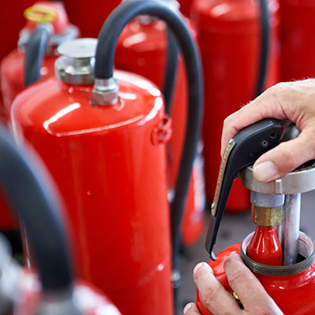Imagine this: a small fire breaks out in your kitchen or workplace. You quickly grab the nearest fire extinguisher, pull the pin, and spray until the flames die down. The danger is over but now the extinguisher is empty. At this point, one important question arises: How many times can a fire extinguisher be refilled?
This is a common concern for both homeowners and businesses. Fire extinguishers are essential safety devices, and knowing whether they can be reused or how often they should be refilled can save lives, money, and property. In this article, we’ll dive deep into the refill process, lifespan, and maintenance of fire extinguishers so you know exactly what to do when yours runs out.
Why Fire Extinguisher Refilling Matters
Fire safety is not a one-time investment. A fire extinguisher is only useful if it is fully charged and ready for action. According to the National Fire Protection Association (NFPA), having functional fire extinguishers can reduce the risk of major property damage by more than 80% in small fire incidents. However, many people neglect regular maintenance or wrongly assume that once used, extinguishers must be replaced.
Refilling a fire extinguisher is both cost-effective and environmentally responsible. Instead of disposing of a perfectly good device, refilling restores its effectiveness, extends its service life, and ensures you remain compliant with safety regulations.
Can All Fire Extinguishers Be Refilled?
Not all extinguishers are designed for refilling. Fire extinguishers fall into two main categories:
1. Disposable (Non-Rechargeable) Fire Extinguishers
These are typically smaller, lightweight models meant for home or personal use. If you see a plastic head with a pressure gauge labeled “Disposable” or “Do Not Recharge,” it means the extinguisher cannot be refilled. Once discharged, it should be replaced.
2. Rechargeable (Refillable) Fire Extinguishers
Larger and more durable, these extinguishers usually have a metal head and are built for long-term use in workplaces, commercial settings, and institutions. They can be refilled multiple times, provided the cylinder passes inspection and is not damaged.
How Many Times Can a Fire Extinguisher Be Refilled?
The number of times a fire extinguisher can be refilled depends on several factors:
1. Type of Fire Extinguisher
- Rechargeable models: These can typically be refilled dozens of times over their lifespan, which usually ranges from 10 to 25 years.
- Disposable models: Cannot be refilled. Once used or after 12 years (when hydrostatic testing is due), they should be replaced.
2. Condition of the Cylinder
Even refillable extinguishers must undergo inspections. If the cylinder is corroded, dented, or fails hydrostatic testing, it must be retired. A well maintained extinguisher can be refilled repeatedly without issue.
3. Frequency of Use
Extinguishers used frequently (for training or actual fire events) will obviously require more refills. However, the physical limit isn’t the number of refills, it’s the structural integrity of the cylinder and valve.
In short: A high quality, rechargeable fire extinguisher can be refilled many times over its lifespan as long as it passes safety inspections.
How Often Should Fire Extinguishers Be Refilled?
Refilling isn’t just about after use. There are strict safety standards that dictate when refilling is required.
- After Every Use: Even if you only discharge a small amount, the extinguisher must be refilled.
- Every 6 Years (Maintenance Standard): NFPA 10 requires a complete teardown, inspection, and refill of stored-pressure extinguishers every six years.
- Every 12 Years (Hydrostatic Testing): This involves pressure testing the cylinder to ensure it can withstand high stress. If it passes, it can continue to be refilled; if not, it must be retired.
Regular monthly visual inspections are also recommended to ensure the pressure gauge is in the green zone and there are no signs of damage.
Benefits of Refilling Fire Extinguishers
Refilling is not just a regulatory requirement it comes with several advantages:
1. Cost-Effectiveness
A new commercial-grade fire extinguisher can cost anywhere between $50 and $200, while refilling usually costs $15 to $50 depending on size and type.
2. Environmental Impact
Instead of discarding metal cylinders, refilling promotes sustainability and reduces waste.
3. Reliability in Emergencies
A refilled extinguisher ensures you’re never caught unprepared. Even a partially discharged extinguisher may fail in a real emergency if not properly refilled.
4. Compliance with Laws and Standards
Businesses are legally required to maintain their extinguishers according to OSHA and NFPA standards. Refilling ensures compliance and avoids costly penalties.
Disadvantages or Limitations of Refilling
While refilling has many benefits, there are some limitations:
- Not all extinguishers qualify: Disposable models cannot be refilled.
- Hidden damage risks: A refilled extinguisher with unseen internal damage might still fail under pressure.
- Ongoing costs: While cheaper than replacement, regular refilling and inspections still come with expenses.
These drawbacks underline the importance of professional servicing rather than DIY refilling.
Tips for Proper Fire Extinguisher Maintenance
- Check the Label: Ensure your extinguisher is rechargeable before considering refilling.
- Hire Certified Professionals: Always have extinguishers refilled by a licensed fire equipment service company.
- Inspect Monthly: Look for leaks, corrosion, or a low pressure gauge.
- Record Maintenance Dates: Keep a log of refills, inspections, and tests to stay compliant.
- Replace When Needed: If the cylinder fails inspection, don’t risk it—replace the extinguisher immediately.
Conclusion
So, how many times can a fire extinguisher be refilled? The answer largely depends on the type and condition of the extinguisher. Rechargeable fire extinguishers can be refilled multiple times, sometimes dozens throughout their lifespan, provided they pass safety inspections and hydrostatic testing. Disposable extinguishers, however, cannot be refilled and must be replaced after use.
Maintaining a ready to use fire extinguisher is not just a regulatory requirement it’s a life-saving responsibility. Whether at home, in your car, or in the workplace, ensuring your extinguisher is full, functional, and regularly inspected could make all the difference in an emergency.
Takeaway: Always refill after use, schedule professional inspections, and never compromise on fire safety. A well maintained extinguisher is one of the simplest yet most powerful tools you have against fire hazards.




